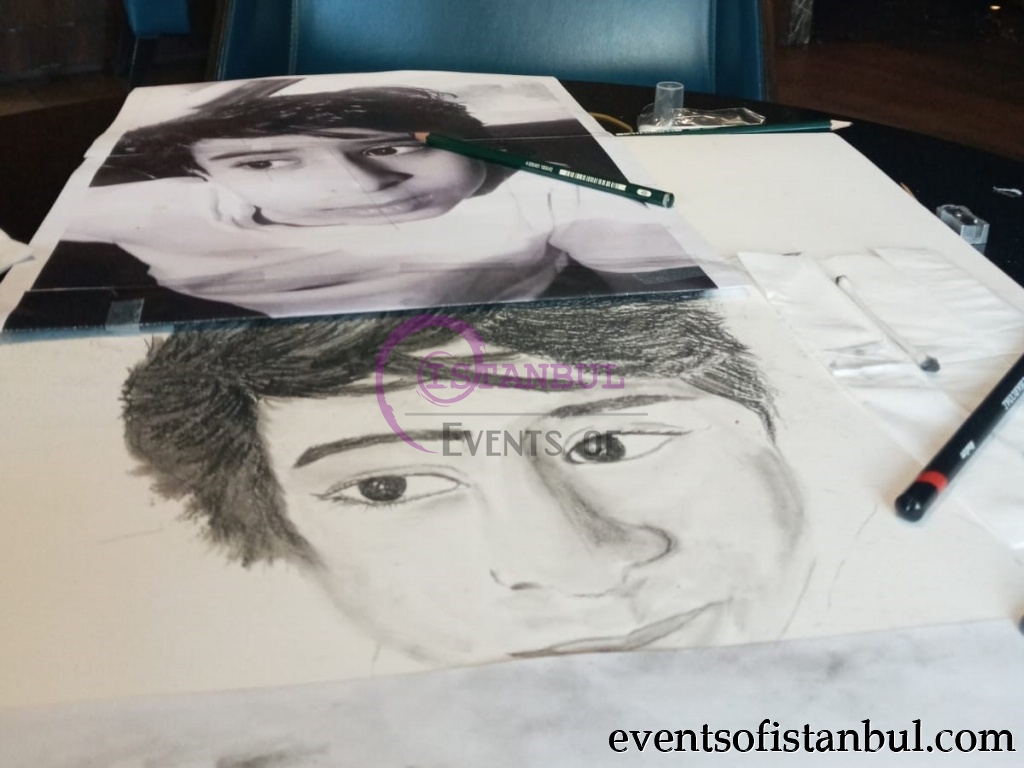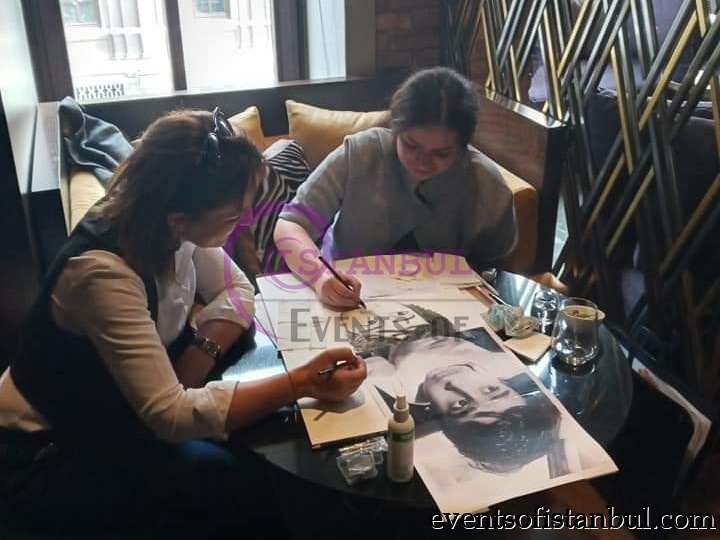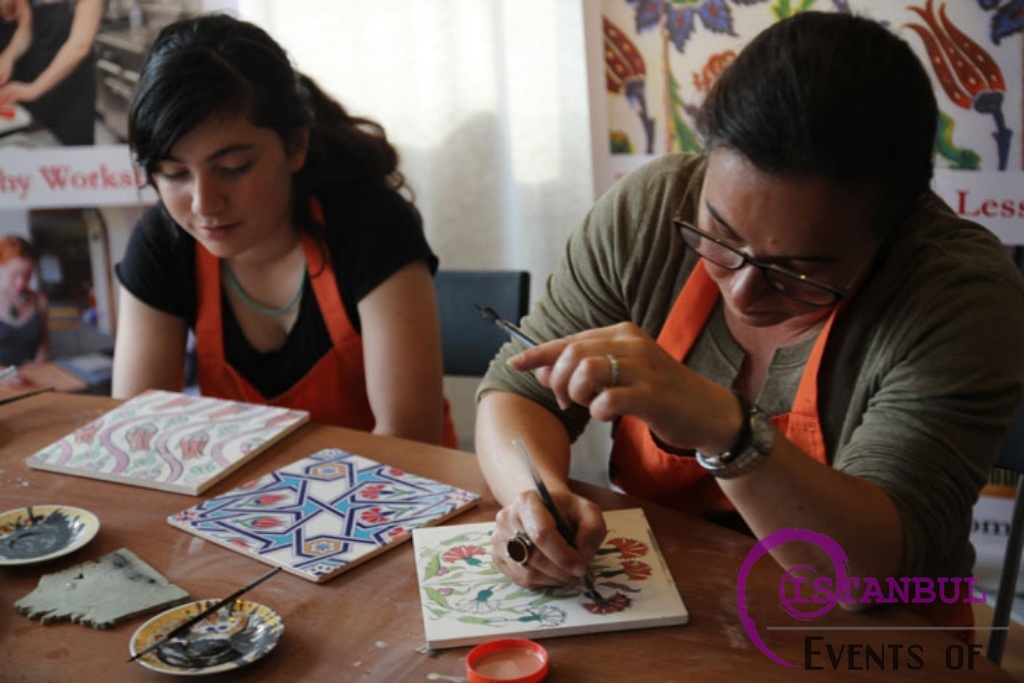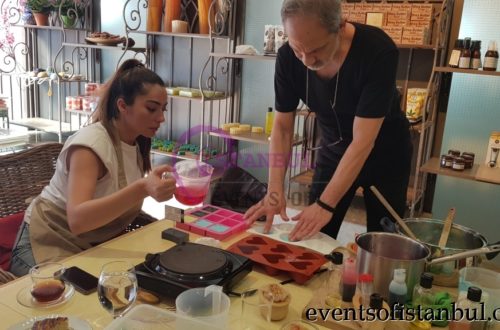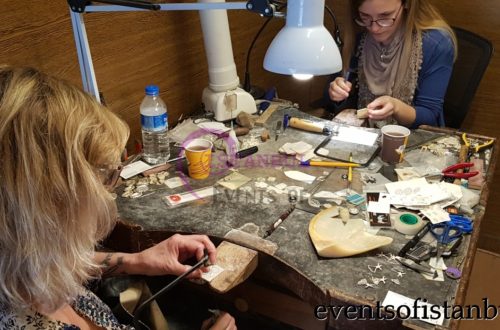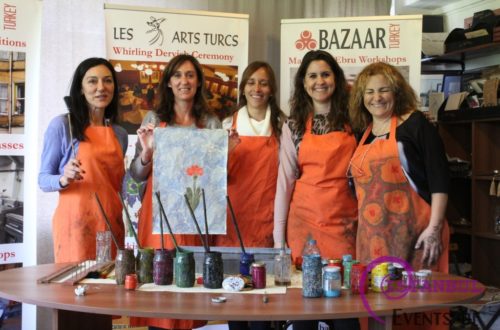
Painting Lesson workshop masterclass in istanbul
Painting Lesson workshop masterclass in istanbul.
- Duration: 2-3 hours (Flexible)
- Location: Sultanahmet / ISTANBUL
- Lesson Teachings: available in English, French, Russian, Turkish
Overview ;
As eventsofistanbul.com, we organise the following painting lessons in our art studio in istanbul.
- Ebru Marbling Painting Lesson
- Tile and Ceramic Painting Lesson
- Miniature Painting Lesson
- Tezhip Illumination Painting Lesson
- Oil Painting Lesson on Canvas
- Watercolor Painting Lesson
- Acrylic Painting Lesson
- Sketch Drawing and Painting Lesson
- Charcoal Drawing Paintig Lesson
- MixedMedia Drawing Lesson
- Graffiti Painting Lesson
What is Included ;
- In our lessons; we can teach beginner & advanced levels of Turkish Paintings.
- Paintings, papers, canvas, tools, brushes are included.
- In the end of the workshop you will have a finished piece of art work.
- If you want, we can make multiple lessons
- Workshop Area, Aprons & Gloves
- Turkish Tea & Water
Meeting Point ;
Here is our Art Studio Address ;
Google Maps : https://goo.gl/maps/uXuyRmELZsx
Events of Istanbul – Les Arts Turcs Art Studio
Alemdar Mh. Incili Cavus St. No: 19 Floor : 3
(Behind The Underground Cistern) Sultanahmet 34110 Istanbul, Turkey
Contact : Mr. Alp or Mr. Nurdogan ( Phone : +90 544 220 10 22 )
E-mail : info@eventsofistanbul.com
Cancellation Policy ; Here in this link you can find the details about our cancellation policy.
Do you want to Order Turkish Arts ?
If you want, we are making custom made Turkish and Ottoman Arts with the sizes and details as you want. For orders, please contact us ;
info@eventsofistanbul.com 00905442201022
Additional Information ;
THE DEVELOPMENT OF TURKISH MODERN ART
Prof. Dr. Semra Germaner
In parallel with the westernization policies of the Ottoman Empire, the art of painting in perspective has developed for 150 years in Turkey. Westernization in Turkey was begun Sultan Mahmud II at the beginning of the nineteenth century, and took root during the reigns of the sons of Sultan Mahmud II, Abdülmecid (1839-1861) and Abdülaziz (1861-1876). The westernization of Turkish painting accelerated in those years and these art works can be seen from the reign of Abdülhamid II and at the time of the Constitutional Monarchy (second Meşrutiyet). Thus, Turkish painting has been developed until today through the cultural policy, which integrated Turkish art with the modern and civilized world, followed the Republic period. In 1795, within the context of art for scientific purpose, with regard to gunnery, a class on perspective painting was taught at the former Istanbul Technical University, Mühendishane-i Berri-i Hümayun. In 1835, following the Mühendishane-i Berri-i Hümayun, the military school, Mekteb-i Fünun-u Harbiye started to give painting classes. Painting classes, originally taught for military purpose, were offered soon after at private schools such as high school, Darrüşşafaka Lise and Galatasaray Sultâni. Graduates of either private school or military school painted only landscape or still life, the subjects of their education. They had no interest in any other fields except for portrait and figure compositions. The first and important Turkish painters, such as Osman Hamdi Bey, Şeker Ahmet Paşa, Süleymaniye Seyyit and Halil Paşa, received their education in Paris and Europe, and this enabled them to work without difficulty in Turkey. In 1883, the former Mimar Sinan Fine Arts School, Sanayi-i Nefise Mekteb-i was established in Istanbul. Thence we can understand that painting was totally understood that time in Turkey. Works with figures can be seen in the paintings of Osman Hamdi Bey and other artists who graduated from Sanayi-i Nefise Mekteb-i Âlisi. A department of Sculpture was also included at this school and many students were educated there. In 1908 – 1910, a group of young artists which graduated from Sanayi-i Nefise Mekteb-i were sent to Europe. In 1913 – 1914, they returned due to the inception of World War I, and continued their activities in Turkey. Avni Lifij, Nazmi Ziya Güran, İbrahim Çallı, Namık İsmail, Feyhaman Duran, Hikmet Onat, Ruhi Arel and Sami Boyar, known as the “1914 generation”, were the first representatives of the Turkish landscape painting. These artists are recognized as “Turkish Impressionists”. In contrast to the art in the previous period, Turkish Impressionists put more importance on lightness, color, design and shape. Most often they painted landscapes, and featured picturesque scenes of Istanbul in their paintings. At the same time, they depicted subjects such as daily life in Istanbul, fashion, and interiors of houses in their paintings, and they created works of portraits and nudes. In 1929, the artists Refik Fazıl Epikman, Cevat Dereli, Şeref Akdik, Mahmud Cuda, Nurullah Berk, Hale Asaf, Ali Avni Çelebi, Zeki Kocamemi, Muhittin Sebati, and sculptor Ratip Aşir Acudoğdu got together and founded the Union of Independent Painters and Sculptors (Müstakil Ressamlar ve Heykeltraşlar Birliği). This was the first community of artists of the Republic era. These artists intended to work for the independence of art and to constitute a foundation for its further development. While the Union of Independent Painters and Sculptors continued their activities, a new group, called “D Group” was founded in 1933. The founders of D Group were Zeki Faik İzer, Nurullah Berk, Elif Naci, Cemal Tollu, Abdin Dino and sculptor, Zühtü Müritoğlu. They applied modern tendency such as Post Cubism, and formed compositions, which stressed construction. D group offered new concepts into the discussion about art and accelerated the process of modernization of Turkish painting. From the 1950’s and later, Turkish painting was developed according to individual local situations, and Turkish artists created their works under the influences of abstract art, abstract expressionism and non-figurative art, which were currently in vogue in United States and Europe. Many works were made in the field of sculpture and other arts. Through the 1960’s, the concept of lyrical expressionism emerged; it emphasized the theme of space (espas), the dynamism of space and color, and put an importance on Turkish Fine arts. The Turkish artists who attempted different shapes of abstract art are Lütfü Günay, Adnan Çoker, Nejat Devrim, Ferruh Başağa, Sabri Berkel and Zeki Faik İzer. Conflict, discussion and dissent regarding social matters were reflected in Abstract Art in different ways in the 1960’s. Potential solutions to social questions can be seen in figurative works. Among those who worked figurative style, there were artists who connected their work to familiar figures in their folklore culture, while others were inspired the cultural heritage of Anatolia. The followers of Bedri Rahmi Eyupoğlu, such as Neşet Günal, Nedim Günsür, Orhan Peker and Turan Erol, wanted to explain through their figurative art about the changeable city and citylife, as well as the Anatolian people and their peculiar life within the context of topical subjects. From 1970-90, individual style can be seen in all of its diversity. Artists like Erol Akyavaş, Burhan Doğançay, Mehmet Güleryüz, Ömer Uluç, Neşe Erdok and Komet created their original works in these years. At the same time, there was another type of artist, who brought a new breath of fresh air and departed in a radical way from the earlier Turkish Fine Arts. Among those were Altan Gürman, Sarkis, Nil Yalter, Füsun Onur and the Society of Art Definition, led Şükrü Aysan. Artists created their works in the field of installation, conceptual art and video art. In the period from the 1990’s until today, Turkish painting has reached a universal level. Turkish artists show high effectiveness in their works and make efforts to expand from Turkey. The plural concepts, formed in accordance with the thought of modern democracy, and boundless creativity, have taken place in Turkish Fine Art and the fields of art have been diversified in parallel with those ideas.





